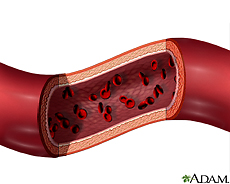 |
 |
 |
||
    |
||||
|
||||
|
Other Health Topics:
Kawasaki Disease
Also called: Mucocutaneous lymph node syndrome
Kawasaki disease is a rare childhood disease. It makes the walls of the blood vessels throughout the body become inflamed. It can affect any type of blood vessel, including the arteries, veins and capillaries. No one knows what causes Kawasaki disease. Symptoms include
Kawasaki disease can't be passed from one child to another. It is mainly treated with medicines. Rarely, medical procedures and surgery also may be used for children whose coronary arteries are affected. Kawasaki disease can't be prevented. However, most children who develop the disease fully recover -- usually within weeks of getting signs and symptoms. Further problems are rare. National Heart, Lung, and Blood Institute
Start Here
|
| Home | Health Topics | Drugs & Supplements | Encyclopedia | Dictionary | News | Directories | Other Resources | |
| Disclaimers | Copyright | Privacy | Accessibility | Quality Guidelines U.S. National Library of Medicine, 8600 Rockville Pike, Bethesda, MD 20894 National Institutes of Health | Department of Health & Human Services |
Date last updated: 13 April 2009 Topic last reviewed: 11 February 2009 |


